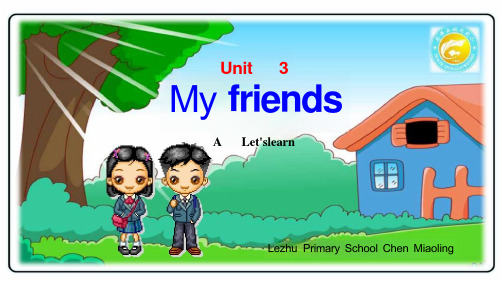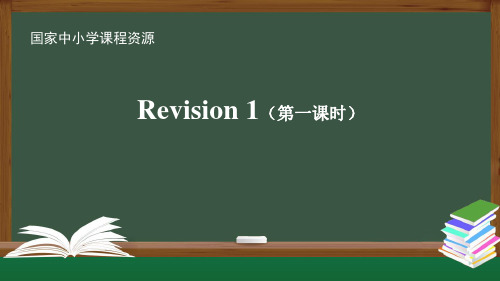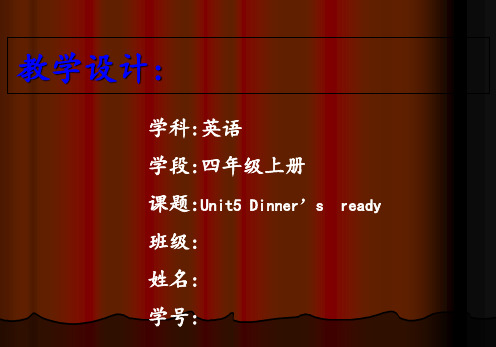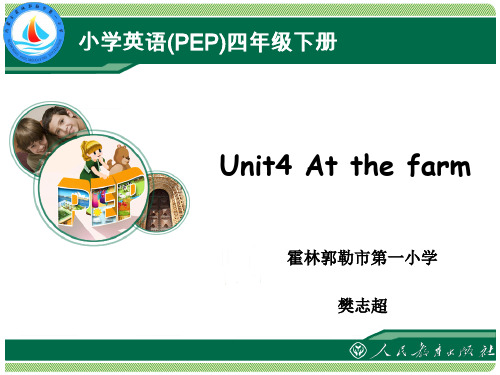人教版小学英语四年级说课 PPT
人教版(PEP)小学英语四年级上册第四单元Unit 4 Let's spell语音课说课课件

Activity 2: Read in pairs
应用实践
1.边读边划出结构:(u-e/u)
2.Read the words together.
fun us up use cute mule
cut tube bus duck
巩固操练本课新结构。
Activity 2: Listen, circle and say
Activity 3 Learn words of u-e.
Let’s read these words. Then what do you remember?
us cut duck up
我记得,这些单词都含有字 母_u_,发音是_Λ__
u [Λ]
学生们通过自己的拼读,感受领悟过程,自发总结出字母u-e结构的发音规则。
学习理解
通过复习前三单元元音字母发音,为新授做好准备。
Activity 3 Tell a story about“u-e”.
学习理解
通过复习前三单元元音字母发音,为新授做好准备。
Activity 3 Learn words of u-e.
Group work:
1.组长带领组员轮流读单词、
拆一拆有哪几个音?
教学过程
应用实践
Applying and practicing
教学过程
应用实践
应用实践
Pay more attention to the words including
“u-e”! (注意符合u-e发音规则的词.)
.
What can you find?
u-e
way
训练学生自然拼读能力。
应用实践
3.能够根据字母u的 两种结构,拼读单词 并根据结构创编新词, 并拼读出单词(迁移 创新)
人教PEP小学英语四年级《My-Friends》全英说课稿课件

Step 1 Warm-up/revision1.Greetings and free talk.2. Sing a song“Boy and girl”(the students have learned in Grade 3)3. Let's talk APlay the cartoon of Let's talk A in class.Students read the talk together.
Teaching Procedure
Blackboard Design
Part I Analysis of the Teaching
Material1.Status and Function2. Analysis of the Students3.Teaching Aims and Demands4. Teaching Key Points and Difficult Points
Key points: The 2 phrases and 2 words.(tall and strong, short and thin, friendly, quiet)2) Difficult points: the applying of thesentence pattern: He's/She's... His/Her nameis...
Let's singBoy and ginlI am a boy and you are a girl. I am a boy and you are a girlI am a boy and you are a girl. Do you want to be my friend?
2019年-2020年新人教版(部编)小学英语四年级上、下册全册全套优质课课件

near 距离近
Presentation
Lead in:
Let's talk
Hi,Zip.Look at my new classroom.
Wow!It's big and nice.
Look at my picture. Is it beautiful?
Where is my toy car?
It's near the desk.
Presentation
Let's play
Practice
What’s in the schoolbag?
I see three books...
Where is the cat?
It's on the desk.
知识点2
用What询问“有什么”
当我们看到一个东西,而因为好奇想知道里面有什么时, 我们可以用“What”来询问。 提问:What’s in the+地点/物品? 回答时直接说出里面的东西就可以了。
What’s in the pencil box?
知识点3 提出行动建议用Let's
课文原句:Let's go and see! 句型结构:let's+动词原形+其他! 上学路上碰到同学可以对他说:
It's near the window.
Where is it?
Sarah and Zhang Peng are talking about(谈论)their new classroom.
Task1:Watch and think(观看并思考)
①Is the classroom big? ②Where is Sarah's picture?
四年级【英语(人教版)】Revision1(第一课时)2课件

国家中小学课程资源
I often go to the museum and
play badminton on the weekend. I
like visiting the museum and
playing badminton .But I like
singing best of all.
I go to a singing club every
What sports do you like?
Where do you play it?
How do you go there?
四年级 英语
国家中小学课程资源
国家中小学课程资源
Lesson 1 Leisure Time on the Weekend
学习 目标
1.能读懂绘本,感受与家人朋友共 度周末的生活乐趣。
Sunday afternoon. It’s not near
my home. I often take a bus
there. I can sing beautiful songs
四年级 英语
with my friends. It’s wonderful.
Summary
国家中小学课程资源
四年级 英语
AT the weekend or ON the weekend?
AT the weekend is used in British English. ON the weekend is used in American English.
四年级 英语
四年级 英语
国家中小学课程资源
国家中小学课程资源
四年级 英语
国家中小学课程资源
Sue
人教版小学英语四年级上册 说课稿PPT幻灯片

活动2:(group work 5') 活动方式:教师引导学生, 四人一个小组,完成课本 59页下面的表格,并要求 学生用What would you like for dinner?/ I'd like some…的句型进行提 问。 活动目的:通过此活动, 学生能够更加全面的了解 和掌握本课关于食物的所 有单词,也直接切入了本 课的重点。
• 1、Greeting. • 2、全班齐唱本单元的歌谣 《Head
shoulder knee and toes》 。 • 3、设计目的:通过歌谣的引入,调动学生
的学习兴趣、吸引学生的注意力,为进入本 课主题作准备。
Step 2、新课呈现及操练(20')
• 1、猜谜语游戏。教师出示准备好的图片,学 生用汉语猜,从而引出本课生词:rice、 beef、bread、milk等。
Sure. Here you are
Ⅲ .Exercises Ⅳ.Homework
What would you like for dinner? I'd like some rice/bread/milk/chicken/
hot dogs/humburgers.
Home work: ……
Thank 级上册 课题:Unit5 Dinner’s ready 班级: 姓名: 学号:
说课内容 :
一、学情分析 二、教材分析 二、教学目标 三、教学重、难点 四、教法与学法 五、教学步骤与活动设计 六、作业布置 七、板书设计
一、学情分析
小学四年级是小学阶段强化学生读写能力的起始阶段,尤其 是培养学生书写的能力的重要时期。对于四年级,其读写课 的重点突出对于单词的书写和记忆。
Step4、巩固练习 (group work 8')
人教版PEP四年级英语上册全册精美ppt课件

课后作业
Homework
1. 把本课let’s talk 读给家长听。 2. 四会本课重点词汇。
39
Unit 1 My classroom
人教版 (三年级起点) 四年级上册
Part B
课前热身
师生一起复习上节课Let’s do 部分内容,同 学们模仿做动作。
Open the door. Turn on the light. Close the window. Put up the picture. Clean the blackboard.
巩固练习
二、给下列句子选择相应的答案。
( B )1. Let’s
the classroom.
A. help
B. clean
C. close
( C )2. Let
clean the blackboard.
A.I
B. my
C. me
( A )3. —
is the green chair?
— It’s near the window.
Unit 1 My classroom
人教版 (三年级起点) 四年级上册
Part A
课前热身
师生对话: T:Hello! Welcome to our school!
Nice to meet you! S: Nice to meet you, too. T: How are you? S: Fine,thank you.
课文原文
课堂互动
Group work
涂一涂,说一说。
课文原文
x √ x √
课文原文
desk chair window
课文朗读
小喇叭朗读开始 了,点一点音箱,一 起学Let's check吧。
人教版PEP小学英语四年级上册Unit 4 A talk 课件PPT

Where is my pen?
Is it in your hand?
No, it isn’t.
Yes, it is!
Practice in pairs.
A: Where is my … ? B: Is it in your …? A: No, it isn’t. B: Is it in your …? A: No, it isn’t. B: Is it in your …? A: Yes, it is.
I have a cat. She’s cute.
Where is she?
Mmm. Is she in the living room?
Is she in the study?
No, she isn’t.
No, she isn’t.
Look! she’s in the kitchen.
Listen and read after it. Try to imitate
freely.
2. Role play the dialogue in groups.
Where is she?
Is she in the study?
Mmm. Is she in the living room?
No, she isn’t.
No, she isn’t.
Look! she’s in the kitchen.
Language points
1. —Where is she? —She’s in the kitchen.
【详解】问句是一个特殊疑问句。回答的时候不能像回答一般 疑问句一样用yes或no,而要根据疑问词所问具体情
况回答。 句型结构:Where + be动词 (is/are) + 主语? 回eg答. :—主W语her+e bies动A词my?(is/are) + 介词短语. — She is in the living room. — Where is he? — He is in the kitchen.
人教版PEP四年级英语上册全册精美ppt课件

What’s in your schoolbag?
A Chinese book and a maths book.
What’s in your schoolbag?
What’s in your schoolbag?
An English book, a Chinese book ,a maths book and four storybooks.
Unit 3 My friends 第一课时
Guessing game
• It is so big and tall. It has a long nose ,a short tail and two large ears like fans. It is from Africa.
• It’s small. It has two long eats and two red eyes. What is it?
Unit 1 My classroom
Let’s re’s review
classroom 教室
Let’s review
blackboard
picture
window light door
Let’s review
Dialogue practice:
1. We have a … 2. What’s in the classroom? 3. Where is it? 4. It’s …
Let’s talk
Let me clean the room!
Let’s talk
Let me help you.
Let’s talk
Let me help you.
Thank you!
Let’s talk
人教版PEP四年级英语上册全册PPT课件

9/22/2023
单词新朋友
clean 打扫 help 帮助 teacher’s desቤተ መጻሕፍቲ ባይዱ 讲台
9/22/2023
句型新朋友 Let’s clean the classroom. 让我们打扫教室吧。 Let me clean the teacher’s desk. 让我打扫讲台。
9/22/2023
Where is the green book ?
×
It is under the teacher’s desk.
Where is the kite ?
It is near the window.
√
Where is the picture ?
×
It is near the kite.
Where is the blue pencil box ? √ It is on the floor.
9/22/2023
Test
英汉互译。
讲台te_a_c_h_e_r_’s desk floor_地__板___ 计算机_c_o_m_p_u_t_er fan__电__扇__ wall_墙__壁___
9/22/2023
选择正确的答案。
1.Let me __A__ the windows. A. clean B. cleans 2.Where is the ___B___ desk? A. teachers’ B. teacher’s
classroom
Warm-up
唱第一单元的歌 We have a new classroom
What’s in your classroom? Four walls and floor, Pictures and windows, and a yellow door!
2024人教PEP版四年级英语上册PPT课件

人教PEP版四年级英语上册PPT课件目录•Course Introduction and Learning Objectives•Unit Key Knowledge Sorting •Situational dialogue and cultivation of communication skills•Guide to Reading comprehension skills•Improving writing and expression skills•Listening Training and Exam01Course Introductionand LearningObjectivesCharacteristics and Content Introduction of TextbooksRich and diverse topicsThe textbooks cover a wide range of topics including school life, family, friends, hobbies, festivals,etc., which are closely related to students' daily lives and can stimulate their interest in learningEmphasis on practical language skillsThe textbooks focus on cultivating students' practical language skills through various activitiessuch as listening, speaking, reading, and writingCombination of knowledge and cultureThe textbooks are not only teaching language knowledge but also introducing culturalbackground information to help students understand the cultural differences between China andthe WestFourth grade English learning objectives•Master basic vocabulary and grammar: Students should grasp the basic vocabulary and grammar knowledge of English to play a solid foundation for future learning•Develop communication skills: Students should be able to use English to communicate with others in simple situations such as meetings, introductions, and simple conversations•Cultivate reading comprehension ability: Students should be able to read and understand simple English texts and extract key information•Foster learning interest and habits: Students should develop an interest in learning English and form good learning habits such as regular review and autonomous learningTeaching methods andstrategic suggestions•Use multimedia resources: Teachers can use multimedia resources such as PPT courseware, videos, and audio materials to enrich the teaching content and stimulate students' interest in learning •Create authentic language environments: Teachers should create authentic language environments for students to practice their English communication skills•Encourage cooperative learning: Teachers can resource students to work in groups to complete tasks and activities, which can help them develop team work skills and improve their motivation to learn •Different instruction: Teachers should have different instruction according to students' different learning needs and abilities to ensure that each student can achieve their potential in English learning02Unit KeyKnowledgeSortingClassroomDoor Teacher's desk Computer BlackboardWindowa room where teachers teach students an opening in a wall, door, or roof to let in light andair a large, flat surface that is commonly black and that you write on with talk in a classroom an opening in a wall that you can open and close,usually with a handlea desk in a classroom where the teacher stands to teachan electronic device that stores and processes data, and that you can use for tasks such as writingdocuments, browsing the internet, and playing gamesUnit 1 Key Vocabulary and Phrases"There is a..."/"There are..." to describe the existence of something There is a presence structure "I am doing..."/"He/She is doing..." to describe actions that are happeningnowPresent continuous tense"I have..."/"He/She has..." to describe things that people have or have less Simple present tense "in", "on", "under", "near" to describe the position of objects Positions of placeUnit 1 Core Sentence Patterns and Grammar Analysis01Schoolbaga bag that you use to carryyour books and other things to and from school 02Math book a book that contains math problems and exercises 03English book a book that contains English language lessons 04Chinese booka book that contains Chinese language lessons 05Pencil case a small container that you use to hold pencils, pens, and other writing tools 06Storybook a book that contains stories Unit 2 Key Vocabulary and PhrasesUnit 2 Core Sentence Patterns and Grammar Analysis01"I have got..."/"He/She has got..." to express session02Can do something structure: "I can..."/"He/She can..." toexpress capability03Simple present tense with third person singular: "He/Shedoes..." to describe hats or routes04Adjectives to describe objects: "big", "small", "heavy", "light" todescribe the size or weight of objects03Situationaldialogue andcultivation ofcommunication skillsAnalysis of scenario dialogue examplesExtract key informationIdentify the main characters, settings, and plotlines in thedialogue examplesLanguage featuresAnalyze the language used in the dialogue, includingvocabulary, grammar, and promotionCultural backgroundExplain any cultural references or customs that may beunfriendly to studentsCommunication skills guidance and trainingListening skillsTeach students how to listenactively and extract keyinformation from Spoken EnglishSpeaking skillsEnhance students to practicespeaking fluently and clearly, withemphasis on promotion andintegration Interpersonal skills Train students in basicinterpersonal communicationskills, such as greeting,apologizing, and expressingthanksSituation selectionChoose situations that are relevant to the students' lives and interests Assign roles to studentsbased on their personalitiesand language abilitiesProvide necessary props andcosts to enhance theauthenticity of the role playingexperienceEvaluate students'performance based on theirlanguage use,communication skills, andcreativityRole allocation Activity preparation PerformanceevaluationRole playing activity design04Guide toReadingcomprehension skillsPrinciples for selecting reading materialsSuitability for students' English levelMaterials should be neither too difficult nor too easy, but just right to challengeand improve students' reading abilityDiversity of topics and genresExposing students to a wide range of topics and genres can help broaden theirhorizons and develop their interest in readingAuthenticityUsing authentic materials such as news articles, stories, and essays can helpstudents develop a better understanding of English language use in real worldcontextsAnalysis of Reading comprehension question typesMain idea and detail questionsThese questions test students' understanding of the overall theme and specific details of the textVocabulary and grammar questionsThese questions focus on specific words, phrases, or grammatical structures used in the textInference and critical thinking questionsThese questions require students to make inferences based on the information provided in thetext and to think critically about the contentSharing of answering skills and strategies•Previewing the questions before reading: This strategy can help students focus on key information while reading and improving their comprehension efficiency•Skimming and scanning: Skimming investments quickly reading through the text to get a general idea of the content, while scanning investments searching for specific information•Guessing the meaning of unknown words: Students can use context clubs, word formation knowledge, and their own background knowledge to see the meaning of unknown words •Reading for detail: When answering detailed comprehension questions, students should reread the relevant part of the text carefully to ensure they have all the necessary information05Improvingwriting andexpressionskillsIntroduction to Basic Writing RequirementsUnderstanding the writing formatIntroduce the basic format requirements of English writing, includingparagraph structure, punctation, and capitalizationMastering basic vocabulary and grammarEmphasize the importance of basic vocabulary and grammar in writing, andprovide examples and exercises to help students master themDeveloping writing ideasGuide students to develop writing ideas by brainstorming, outlining, and otherpre writing activitiesCorrection of common writing errorsGrammatical errorsIdentify and correct common graphical errors, suchas subject verb agreement, tense consistency, andpresence structureSpelling errorsPoint out common spelling errors and provide tipsfor improving spelling accuracyPuncturation errorsExplain the correct usage of puncture marks, suchas commas, periods, and quota marks, and correctrelated errorsAnalyzing model assessmentsSelect multiple Excel model assessments and analyze their structure, language use, and writing techniquesLearning from model essaysEncourage students to learn from the strengths of model essays and apply them to their own writingImproving writing skills through practiceProvide writing prompts and exercises to help students practice and improvetheir writing skills based on what they have learned from model essaysRecommendation and reference of Excel model essays06ListeningTraining andExamStrategies01 02 03Choose authentic English materials Select materials that are produced by native speakers and feature real life scenarios to expose students to natural language useVary the diversity levelGradually increase the complexity of the listening materials to challenge students and improve their comprehension skillsIncorporate a range of topicsIntroduce a variety of topics to keep students engaged and broad their vocabulary and understanding of different subjectsSuggestions for selecting listening materialsIdentify question typesFamiliarize students with different types of listening questions, such as multiple choices, true or false, and fill in the blanksEncourage students to takenotes while listening,focusing on key words andphrases to aid in recall andcomprehensionTrain students to usecontext clubs and theirexisting knowledge topredict possible answersbefore hearing the entirequestion or response Teach notetakingstrategiesDevelopprediction skillsAnalysis of listening question types and problem solving skillsSimulation testing and self-assessment•Conduct regular practice tests: Administrator simulatedlistening tests to help students become family witTHANKS感谢观看。
人教版小学英语四年级说课PPT

第一课时
教学目标 1.能听,说,认读单词tomato,potato carrot green bean 及其复数形式。 2.能够运用句型they are ...来描述蔬菜的特征。 3.能够有节奏的说唱歌谣。
达 成 策 略
第二课时
教学目标: 1.能听懂,会说句型Are these...?Yes,they are .What are these? They are...并在实际情境中运用。 2.能够进行角色扮演。
字母组合 or的发音 规则
区别与运用: these, those
难点
单 元 重 难 点
说教学
Hale Waihona Puke 单元教学评价单元教学设计
单元教学设计
词汇教学
会话教学 阅读教学 语音教学 综合性教 学
第一课时 Let’s learn(A) Let’s chant 第二课时 Let’s talk(A) Let’s play 第三课时 Let’s learn(B) Draw and say 第四课时 Let’s talk(B) Let’s play 第五课时 Read and write Let’s check let’s sing 第六课时 Let’s spell Story time
Part B
Part C
四单元内容结构
两个词汇教学分别是蔬菜和家 禽的英语名称,同时提供了句 型Look at the green beans. They are so long.I like ... These are sheep. Wow! They are so cute.进行替换 练习。
Let’s learn
Part A Part B
Start
Part C
- 1、下载文档前请自行甄别文档内容的完整性,平台不提供额外的编辑、内容补充、找答案等附加服务。
- 2、"仅部分预览"的文档,不可在线预览部分如存在完整性等问题,可反馈申请退款(可完整预览的文档不适用该条件!)。
- 3、如文档侵犯您的权益,请联系客服反馈,我们会尽快为您处理(人工客服工作时间:9:00-18:30)。
第一课时
教学目标 1.能听,说,认读单词tomato,potato carrot green bean及其复数形式。 2.能够运用句型they are ...来描述蔬菜的特征。 3.能够有节奏的说唱歌谣。
达 成 策 略
第二课时
教学目标: 1.能听懂,会说句型Are these...?Yes,they are .What are these?
spell
辨音能力
Start
Part A
Part B Part C
四单元内容结构
巩固拓展语言知识的基础上, 培养学生良好的阅读习惯
Read and write
Part A
Part B
Part C
Start
四单元内容结构
Part A Start
Part B
以风趣幽默的小 故事紧扣本单元 核心内容,并进 行趣味拓展
能够仿写句子。
达 成字母组合or的发音规则。 2.学生能够读出符or的发音规则的单词。
并能够根据发音拼写出符合or发音规则的单词。
达 成 策 略
单元教学评价 单元教学设计
•词汇 •句型 •对话
知识技能
知识技能及 考察方法
•听写 •对话 •游戏 •测验
They are...并在实际情境中运用。 2.能够进行角色扮演。
达 成 策 略
第三课时
教学目标: 1.能听,说,认读单词hen,horse sheep cow 及其复数形式。 2.能够正确使用上述单词和these/those介绍各种农场动物及蔬菜。 3.完成说一说,画一画部分内容。
达 成 策 略
英语书吧。
• 3.网络资源:英语网站、 英语教育动画等
Part C
单元内容结 构
说 教 材
知识立体整合
纵向整合
四下 三上
四下
四下 四下
横向整合
说目标
小学英语(PEP)四年级下册
学段目标 说 课 标
综合运用语言能力
学段目标
语言技能 语言知识
学习策略
课 程 总 体 目 标
文化意识 情感态度
四年级下册 Unit4 At the farm
学 段 目 标
Let’s learn
Part A Start
Part B Part C
四单元内容结构
在情景中植入核心句型, 通过巩固与拓展,使学生 能够在生活中正确的使用 语言
Let’s talk
Let’s
talk
Part A
Part B
Start
Part C
四单元内容结构
引导学生发现or字母组合
Let’s 发音的规则,训练孩子的
熟练运用 单词句型 描述农场 四会单词 和句型
重点
字母组合 or的发音 规则
区别与运用: these, those
难点
单 元 重 难 点
说教学
单元教学评价 单元教学设计
单元教学设计
词汇教学 会话教学
阅读教学 语音教学 综合性教
学
第一课时
Let’s learn(A) Let’s chant 第二课时
•人教版小学英语四年级说课
小学英语(PEP)四年级下册 说目标
说教材
小学英语(PEP)四年级下册
单元内容结 构
说 教 材
谈论时间
介绍天气
Unit3 Weather
Unit2 What time is it?
Recycle1
参观农场
Unit4 At the farm
服装服饰
Unit5 My clothes
对英语
能根据学指令段目标演能,角唱色歌扮,
做动作、做游戏 说歌谣,读
做事情
小故事
有好奇心,
喜欢听他人
说英语
一
级
目
标
对外国文化 习俗感兴趣
1.能够听、说、认读句型:Are
these carrots? Yes,they are./No,they aren’t. What are these/those? They’re tomatoes/sheep.Are they hens? No,they aren’t. They’re ducks.
2.能够掌握字母组合or的发音规则
创设情景,激发学生 学习兴趣加强学习 策略指导,培养学生 自主学习能力
过程与方法
能够听、说、认读单词: tomato, green bean
单
potato,carrot,cow,hen,
元
sheep,horse及其复数形式
目
标
情感态度与价 值观
了解几条 和动物相关 的习语
考察方法
单元教学评价
评价表
家长评价 (请根据自己表现画出星级,最多6颗 )
非常满 比较 还需 得星数
意
满意 努力 目
学生自评
学生互评
家长评价
教师评价
我想说的一 句话
单元教学评价 单元教学设计
• 1.主题资源:包括课本、
网练络习资册源、教师实用物书资、源多
媒体设施。
课外阅
文本资源 • 2.校本资源:教师团队、 读资源
第四课时
教学目标: 1.能听懂,会说句型What are those? They are...
Are they...? No,they aren’t.并在实际情境中运用 2.能够进行角色扮演。
those
达
成
策
略
these
第五课时
教学目标: 1.能在图片的帮助下听懂和读懂简单的小故事,
在语境中理解新词:garden goat eat 意思。 2.能够完成读后圈词的活动。 3.能够按意群并以正确的语音 语调 朗读短文,
Part B Part C
四单元内容结构
两个词汇教学分别是蔬菜和家
禽的英语名称,同时提供了句 型Look at the green beans. They are so long.I like ... These are sheep. Wow! They are so cute.进行替换 练习。
Let’s learn
Recycle2
Unit1 My school
介绍校舍的分布
单 元
编
排
体
例
Unit 6 Shopping
购物
本册书单元编排体例
•大家有疑问的,可以询问和交流
•可以互相讨论下,但要小声点
单元内容结 构
说 教 材
四单元内容结构
Part A
Start
通过展示学生 们参观农场的 情景呈现核心 词汇和句型
Let’s talk(A) Let’s play
第三课时 Let’s learn(B) Draw and say
第四课时 Let’s talk(B)
Let’s play 第五课时
Read and write Let’s check let’s sing
第六课时
Let’s spell Story time
